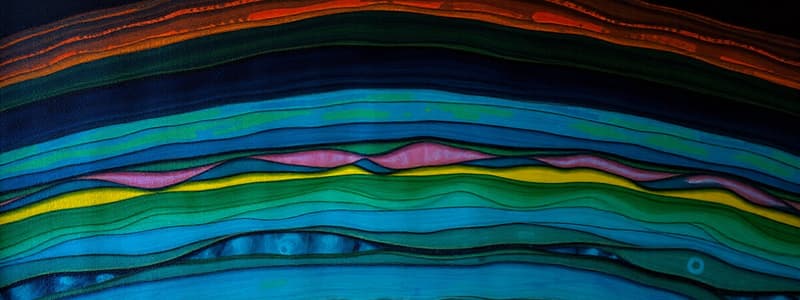Podcast
Questions and Answers
Which layer of the Earth is primarily composed of basalt rock?
Which layer of the Earth is primarily composed of basalt rock?
- Inner Core
- Mantle
- Continental Crust
- Oceanic Crust (correct)
What is the composition of the Earth's core primarily made of?
What is the composition of the Earth's core primarily made of?
- Iron and nickel alloy (correct)
- Magma and minerals
- Granite and basalt
- Silicates and magnesium
At what depth does the mantle begin to flow slowly?
At what depth does the mantle begin to flow slowly?
- 100km to 150km (correct)
- 200km
- 300km
- 50km
Which term describes the outermost layer of the Earth?
Which term describes the outermost layer of the Earth?
What is the primary reason oceanic crust is denser than continental crust?
What is the primary reason oceanic crust is denser than continental crust?
Which layer of the Earth is responsible for the flow of heat through convection?
Which layer of the Earth is responsible for the flow of heat through convection?
What characteristic is associated with the lithosphere layer of the Earth?
What characteristic is associated with the lithosphere layer of the Earth?
Which layer of the Earth is described as being rigid and can bend slightly but not flow?
Which layer of the Earth is described as being rigid and can bend slightly but not flow?
What characterizes the asthenosphere?
What characterizes the asthenosphere?
Which of the following is responsible for the generation of Earth's magnetic field?
Which of the following is responsible for the generation of Earth's magnetic field?
What does the Mohorovičić Discontinuity separate?
What does the Mohorovičić Discontinuity separate?
How does the inner core differ from the outer core in terms of its state under pressure?
How does the inner core differ from the outer core in terms of its state under pressure?
What is the main reason that plates in the lithosphere can move over the asthenosphere?
What is the main reason that plates in the lithosphere can move over the asthenosphere?
Flashcards are hidden until you start studying
Study Notes
Earth's Differentiation
- Earth is separated into concentric layers based on composition and density
- Dense materials like iron and nickel sank to form the core
- Lighter silicates rose to form the mantle and crust
Compositional Layers
- Based on material composition
- Crust: Outermost; oxygen is most abundant
- Continental Crust: 20-90km thick; less dense (2.7g/cm3); mainly granite & andesite; more pores
- Oceanic Crust: 5-10km thick; denser (3g/cm3); mainly basalt; fewer pores
- Mantle: Beneath the crust; ~2,900km thick; 67% Earth's mass; solid rock; density ranging from 3.5-5.5 g/cm3; made of ultramafic rock called peridotite
- Core: Innermost; iron-nickel alloy; 31% of Earth's composition; source of internal heat
- Outer Core: ~2,255km thick; liquid due to high temperature; responsible for Earth's magnetic field
- Inner Core: ~1,220km thick; solid due to intense pressure; slightly faster rotation due to magnetic field
Mechanical Layers
- Based on temperature and seismic wave penetration
- Lithosphere: Rigid, solid (upper mantle + crust); broken into plates that move over the asthenosphere
- Asthenosphere: Part of upper mantle; 'plastic' and flows slowly; heated to 1280°C or 2330°F
- Lower Mantle/Mesosphere: Region of increased pressure; lowest part of mantle, near outer core
Plate Tectonic Theory
- Lithosphere is divided into individual pieces (plates)
- Plates move over the asthenosphere due to convection currents
Boundaries and Seismic Discontinuities
- Seismic discontinuity: Abrupt change in seismic wave velocity at boundaries
- Mohorovičić Discontinuity: Boundary between crust and mantle; named after seismologist Andrija Mohorovičić
- Andrija discovered a change in seismic wave behavior at depths greater than 200km
Studying That Suits You
Use AI to generate personalized quizzes and flashcards to suit your learning preferences.




